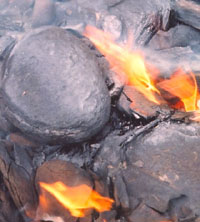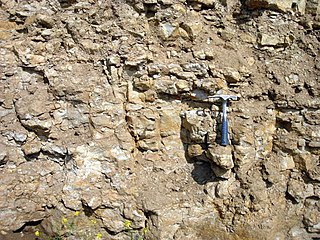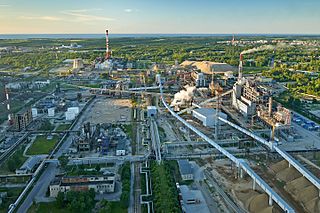Related Research Articles

Oil shale is an organic-rich fine-grained sedimentary rock containing kerogen from which liquid hydrocarbons can be produced. In addition to kerogen, general composition of oil shales constitutes inorganic substance and bitumens. Based on their deposition environment, oil shales are classified as marine, lacustrine and terrestrial oil shales. Oil shales differ from oil-bearing shales, shale deposits that contain petroleum that is sometimes produced from drilled wells. Examples of oil-bearing shales are the Bakken Formation, Pierre Shale, Niobrara Formation, and Eagle Ford Formation. Accordingly, shale oil produced from oil shale should not be confused with tight oil, which is also frequently called shale oil.
Unconventional oil is petroleum produced or extracted using techniques other than the conventional method. Industry and governments across the globe are investing in unconventional oil sources due to the increasing scarcity of conventional oil reserves. Unconventional oil and gas have already made a dent in international energy linkages by reducing US energy import dependency.
Shale oil is an unconventional oil produced from oil shale rock fragments by pyrolysis, hydrogenation, or thermal dissolution. These processes convert the organic matter within the rock (kerogen) into synthetic oil and gas. The resulting oil can be used immediately as a fuel or upgraded to meet refinery feedstock specifications by adding hydrogen and removing impurities such as sulfur and nitrogen. The refined products can be used for the same purposes as those derived from crude oil.

Synthetic fuel or synfuel is a liquid fuel, or sometimes gaseous fuel, obtained from syngas, a mixture of carbon monoxide and hydrogen, in which the syngas was derived from gasification of solid feedstocks such as coal or biomass or by reforming of natural gas.

The Shell in situ conversion process is an in situ shale oil extraction technology to convert kerogen in oil shale to shale oil. It is developed by the Shell Oil Company.

Oil shale geology is a branch of geologic sciences which studies the formation and composition of oil shales–fine-grained sedimentary rocks containing significant amounts of kerogen, and belonging to the group of sapropel fuels. Oil shale formation takes place in a number of depositional settings and has considerable compositional variation. Oil shales can be classified by their composition or by their depositional environment. Much of the organic matter in oil shales is of algal origin, but may also include remains of vascular land plants. Three major type of organic matter (macerals) in oil shale are telalginite, lamalginite, and bituminite. Some oil shale deposits also contain metals which include vanadium, zinc, copper, and uranium.
Oil shale reserves refers to oil shale resources that are economically recoverable under current economic conditions and technological abilities. Oil shale deposits range from small presently economically unrecoverable to large potentially recoverable resources. Defining oil shale reserves is difficult, as the chemical composition of different oil shales, as well as their kerogen content and extraction technologies, vary significantly. The economic feasibility of oil shale extraction is highly dependent on the price of conventional oil; if the price of crude oil per barrel is less than the production price per barrel of oil shale, it is uneconomic.

The oil shale industry is an industry of mining and processing of oil shale—a fine-grained sedimentary rock, containing significant amounts of kerogen, from which liquid hydrocarbons can be manufactured. The industry has developed in Brazil, China, Estonia and to some extent in Germany and Russia. Several other countries are currently conducting research on their oil shale reserves and production methods to improve efficiency and recovery. Estonia accounted for about 70% of the world's oil shale production in a study published in 2005.

Shale oil extraction is an industrial process for unconventional oil production. This process converts kerogen in oil shale into shale oil by pyrolysis, hydrogenation, or thermal dissolution. The resultant shale oil is used as fuel oil or upgraded to meet refinery feedstock specifications by adding hydrogen and removing sulfur and nitrogen impurities.
Oil shale economics deals with the economic feasibility of oil shale extraction and processing. Although usually oil shale economics is understood as shale oil extraction economics, the wider approach evaluates usage of oil shale as whole, including for the oil-shale-fired power generation and production of by-products during retorting or shale oil upgrading processes.

Environmental impact of the oil shale industry includes the consideration of issues such as land use, waste management, and water and air pollution caused by the extraction and processing of oil shale. Surface mining of oil shale deposits causes the usual environmental impacts of open-pit mining. In addition, the combustion and thermal processing generate waste material, which must be disposed of, and harmful atmospheric emissions, including carbon dioxide, a major greenhouse gas. Experimental in-situ conversion processes and carbon capture and storage technologies may reduce some of these concerns in future, but may raise others, such as the pollution of groundwater.

The history of the oil shale industry started in ancient times. The modern industrial use of oil shale for oil extraction dates to the mid-19th century and started growing just before World War I because of the mass production of automobiles and trucks and the supposed shortage of gasoline for transportation needs. Between the World Wars oil shale projects were begun in several countries.
Independent Energy Partners, Inc. (IEP) is an oil shale resources company based in Parker, Colorado, the United States. It is a developer of the Geothermic Fuels Cells Process, an in-situ shale oil extraction process. CEO of the company is Alan K. Forbes.
Mountain West Energy, LLC is an American unconventional oil recovery technology research and development company based in Orem, Utah. It is a developer of the In-situ Vapor Extraction Technology, an in-situ shale oil extraction technology. The company owns 880 acres (3.6 km2) oil shale leases in the Uintah Basin, Uintah County, Utah.

Oil shale in Jordan represents a significant resource. Oil shale deposits in Jordan underlie more than 60% of Jordanian territory. The total resources amounts to 31 billion tonnes of oil shale.
Chevron CRUSH is an experimental in situ shale oil extraction technology to convert kerogen in oil shale to shale oil. The name stands for Chevron's Technology for the Recovery and Upgrading of Oil from Shale. It is developed jointly by Chevron Corporation and the Los Alamos National Laboratory.
ExxonMobil Electrofrac is an in situ shale oil extraction technology proposed by ExxonMobil for converting kerogen in oil shale to shale oil.
In the United States, synthetic fuels are of increasing importance due to the price of crude oil, and geopolitical and economic considerations.
The LLNL RISE process was an experimental shale oil extraction technology developed by the Lawrence Livermore National Laboratory. The name comes from the abbreviation of the Lawrence Livermore National Laboratory and words 'rubble in situ extraction'.
Oil shale in Morocco represents a significant potential resource. The ten known oil shale deposits in Morocco contain over 53.381 billion barrels of shale oil. Although Moroccan oil shale has been studied since the 1930s and several pilot plants have extracted shale oil from the local formations, commercial extraction was not underway as of 2011.
References
- ↑ "General Synfuels International, Inc. appoints Blue-Ribbon Energy and Environmental Advisory Board" (Press release). Earth Search Sciences. 2010-06-09. Retrieved 2012-05-24.
- ↑ Gearino, Jeff (2009-06-02). "Wyo gets oil shale project". Casper Star-Tribune. Lee Enterprises. Retrieved 2010-07-02.
- 1 2 "General Synfuels International Announces Formation Of Technology Fund For Oil Shale Development" (Press release). Earth Search Sciences, Inc. 2010-04-29. Retrieved 2010-07-02.
- ↑ Secure Fuels from Domestic Resources: The Continuing Evolution of America's Oil Shale and Tar Sands Industries (PDF) (4th ed.). United States Department of Energy. 2010. pp. 44–45. Archived from the original (PDF) on 2011-04-27. Retrieved 2011-05-06.
- ↑ "General Synfuels to Test In-Situ Oil Shale Gasification Technology in Wyoming and Colorado". Green Car Congress . BioAge Group, LLC. 2009-05-03. Retrieved 2010-07-02.